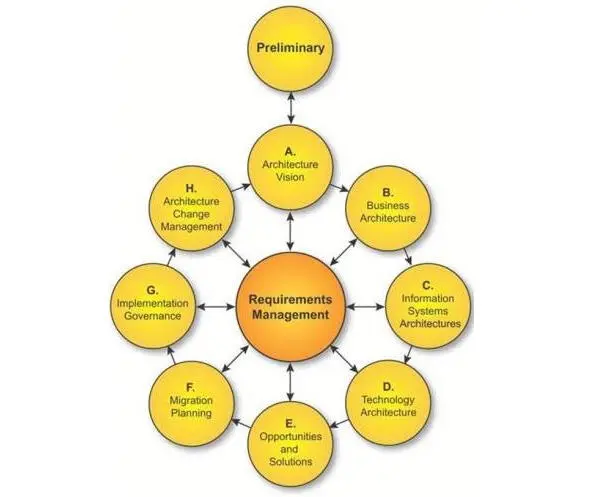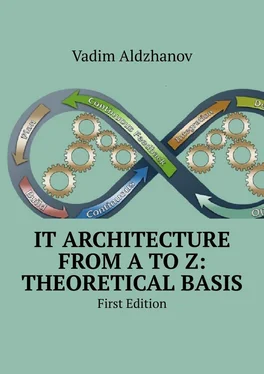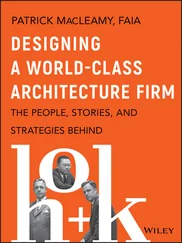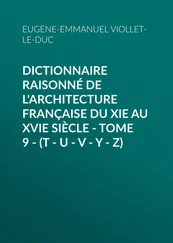Even though the TOGAF methodology and Zakhman infrastructure are merged into the “enterprise infrastructures” category, their principles, structures and competencies are different. TOGAF is a functional and dynamic infrastructure including guidelines for process use patterns. While the Zachman framework is a static architecture structure, it is the most effective one for applying the analysis and meta-analysis of infrastructure frameworks. Despite the significant differences in these frameworks, they can be used together.
Creating a specific enterprise architecture is considered as a transition from a general architecture to a specialized one. The architecture development methodology in TOGAF model is the process of making such a transition. The most generalized architectures in TOGAF model are called fundamental architectures. These principles of architecture can theoretically be used by nearly any IT organization in the world.
The next TOGAF specialization level is called system-wide architectures. These principles can be traced in many, but not all types of enterprises. The next one is an industry level of architecture. These principles are specific for enterprises engaged in one area of activity. The final level is the organization architecture level. This is the highest TOGAF specialization level. These are architecture of specific enterprises.
TOGAF includes two main components:
• Architecture Development Method defining the process of architecture development
• Foundation Architecture supplemented with a corresponding resource database, including descriptions of architectural principles, examples of implementation, as well as ADML.
TOGAF description includes seven (7) parts:
• Introduction contains a high-level description of the key concepts of the Architecture in general and TOGAF in particular.
• Architecture Development Method (ADM) is key TOGAF part, describing the step-by-step methodology for developing the Enterprise Architecture.
• ADM Guidelines and Techniques includes a description of the rules and techniques used in TOGAF ADM.
• Architecture Content Framework describes the approach to describe the Enterprise Architecture and contains meta-model of architectural artifacts, structure and description of typical architectural artifacts.
• Enterprise Continuum & Tools addresses the approach to architecture repository of architectural activities results.
• TOGAF Reference Models describes the reference models that to use in projects.
• Architecture Capability Framework approaches the organization of architectural practice in the company i.e. structure, processes, roles, skills and authorities required.
As the main processes of building Enterprise Architecture, it is important to implement only four key processes:
• Creation and development of Enterprise Architecture;
• Management of change;
• Monitoring the implementation of architectural solutions;
• Practice management.
TOGAF Architecture Development Method (ADM)
The processes of creation and development, change management, control of the implementation of architectural solutions in TOGAF are integrated into a single Architecture Development Method (ADM). This method can and should be adapted to the company’s objectives at all levels of architecture development. At the same time, there is no need to develop all possible documents and go too deep into details. ADM offers a ready-made set of techniques, tools, templates, and check sheets for each stage. The Architecture Development Method (ADM) contains ten phases. Each phase is divided into sub-processes (stages), individual works, and so on.

TOGAF Architecture Development Method (ADM)
For example, phase D includes the following main sub-processes:
•Description of the current technological architecture.
° An overview of the business architecture, data architecture and applications for defining the initial data and the required level of detail.
° Description of the current system with the required level of detail, selected to identify the required changes when creating the target architecture, i.e. the registry software and hardware platforms used.
° Identification and description of elementary architectural blocks to be used in the new architecture. In fact, it is a question of available architectural templates.
° Development of a draft technical report summarizing the main results of the study of the current state and the possibility of using typical units.
° Submission of the draft report for review, analysis of comments and introduction of amendments, if required.
• Creation of the target technological architecture.
° Description of the current system using TOGAF terms.
° Defining architecture perspectives (representations).
° Creation of a target architecture model.
° Definition of IT services.
° Confirmation of business requirements.
° Definition of architecture and blocks used (templates).
° Carrying out a gap analysis.
Table: Phases and Objectives of the ADM
The main objectives of the preliminary phase are:
• To create an architectural practice;
• To prepare the company for the launch of architectural projects;
• To enlist the leadership support;
• To create architectural principles;
• To adapt the methodology for the company’s goals and objectives.
The main objectives of phase A (Architecture Vision) are:
• To launch an architectural project, define goals and objectives, framework, scope and constraints of the project, develop a vision of the architecture, define the relevant stakeholders;
• To develop a “project charter” and get a formal confirmation of the project start.
The main objectives of phase B (Business Architecture) are:
• To develop an architecture with a description of the current and target architecture;
• To conduct gap analysis.
The main objectives of phase C (Information Systems Architectures) are:
• To develop an architecture with a description of the current and target architecture;
• To conduct gap analysis.
The main objectives of phase D (Technology Architecture) are:
• To develop an architecture with a description of the current and target architecture;
• To conduct gap analysis.
The main objectives of phase Е (Opportunities and Solutions) are:
• To plan the implementation of project objectives;
• To identify major implementation projects and group them into transition architectures.
The main objectives of phase F (Migration Planning) are:
• To conduct cost and risk analysis;
• To develop a detailed implementation and migration plan.
The main objectives of phase G (Implementation Governance) are:
• To govern the overall project implementation;
• To prepare architectural contracts.
• To ensure conformance with the defined architecture by implementation projects.
The objectives of phase H (Architecture Change Management) are:
• To prepare for the next turn of the Architecture Development Cycle.
• To ensure the compliance of the change management with the actual needs of the business and maximum value to the business.
The main objectives of the Architecture Requirements Management are:
• To collect and agree on business requirements at each phase of the architectural project;
Читать дальше













